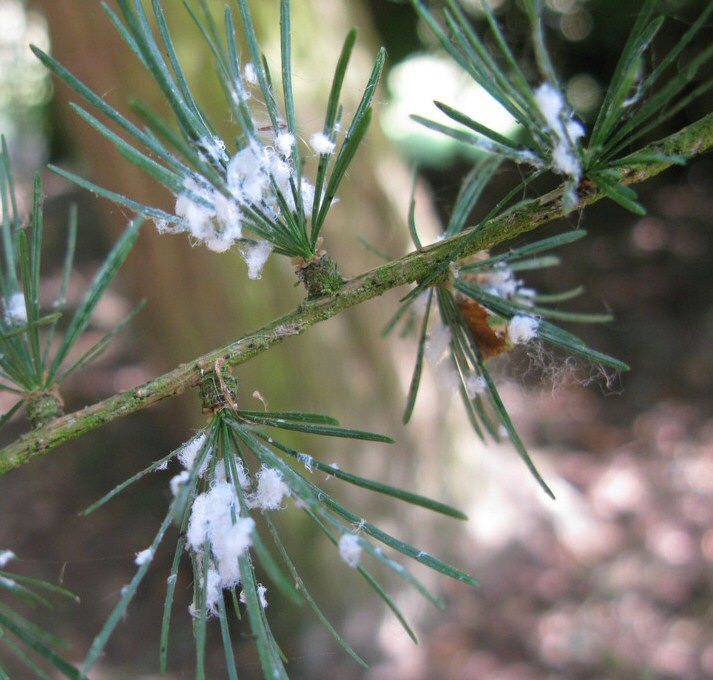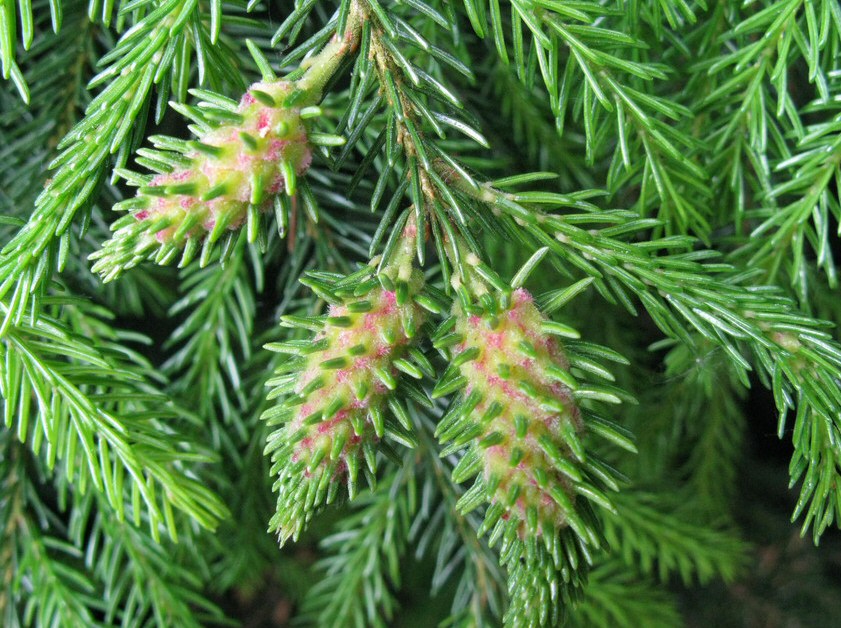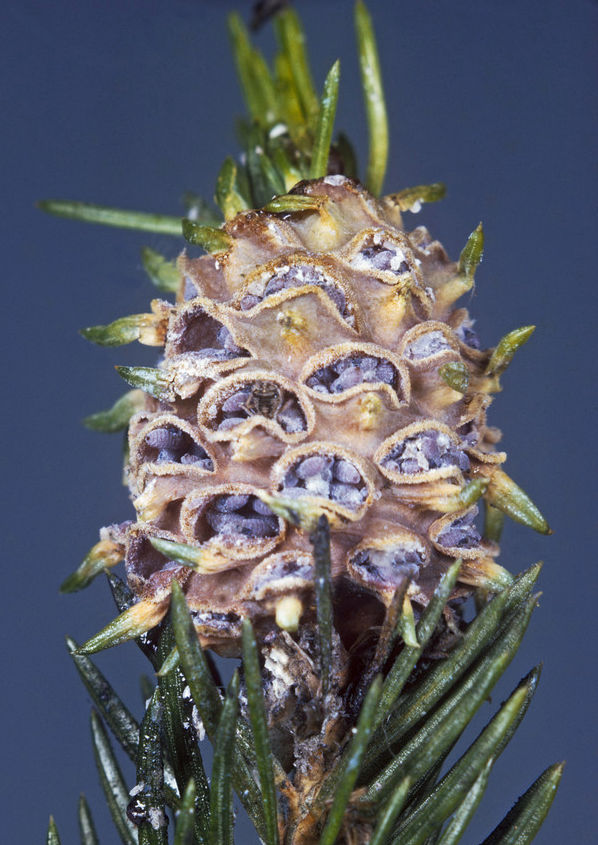Adelgids - "Conifer woolly aphids"
The Family Adelgidae contains sap-sucking true bugs (Hemiptera) in the sub-order Sternorrhyncha that only occur on conifers. Mostly 2-3mm in length, they are closely related to aphids and are sometimes called conifer woolly aphids. Note that some true aphids also occur on conifers. The actual insect is hard to see under its woolly wax covering.
Species in Britain and Ireland
Britain and Ireland have only three native conifer species (Scots pine, juniper and yew), of which only Scots pine has an adelgid, Pineus pini, associated with it. The other 10 adelgid species found in these countries are non-native species living on imported conifers such as Picea, Abies, Pseudotsuga and Larix species. Non-native adelgids on garden conifers include Sacciphantes viridis and Trisetacus laricis , which cause pineapple galls on Norway spruce, Gilletteela cooleyi on Douglas fir, and Adelges laricis on larch. Adelges laricis also occurs on larch but is not regarded as a gall causer.


Biology
Adelgids feed by sucking sap from the foliage and young stems of conifers, or they feed inside galls they have initiated on their host plant. These small insects are often covered with a fluffy white wax that is secreted from their bodies, especially by free-living adelgids on the foliage of larch and Douglas fir. Heavy infestations can result in yellowish foliage that may become sticky due to the sugary honeydew that adelgids excrete.
Life cycle
Unlike aphids, adelgids are egg layers and do not give live birth to nymphs, but they can share sexual and asexual cycles, and winged and wingless forms.
![Adelges piceae Photo: Gilles San Martin from Namur, Belgium [CC BY-SA 2.0 (https://creativecommons.org/licenses/by-sa/2.0)]](images/1024px-Balsam_woolly_adelgid_(31899465560)_(cropped).jpg)
_(14480056502).jpg)
Adelgids often have complex life cycles involving gall-forming and free-living generations, which may occur on different species of conifer. An example is the Douglas fir adelgid, which has generations that alternate between Douglas fir and Sitka spruce. Overwintered adults on Douglas fir will lay eggs in spring. The adelgid nymphs feed on the underside of the leaves, with each insect being hidden under a coating of white waxy filaments. In mid-summer, winged and wingless adults develop. The latter remain on Douglas fir but the winged forms fly off in search of Sitka spruce. Those that find Sitka spruce will overwinter there and in spring will lay eggs near the buds. The newly hatched nymphs feed on a developing bud and secrete chemicals into it that prevent normal shoot extension. Instead the shoot tip becomes abnormally swollen and contains cavities in which the adelgid nymphs live and feed. In mid-summer, the galls break open and the winged adults are able to escape and migrate back to a Douglas fir.
![Adelges laricis Larch adelgid egg cluster S. Rae from Scotland, UK [CC BY 2.0 (https://creativecommons.org/licenses/by/2.0)]](images/Adelges_laricis_(Larch_adelgid)_egg_cluster_-_Flickr_-_S._Rae.jpg)
Egg cluster of Adelges laricis the larch adelgid

Left: native Scot pine adelgid Pineus pini Right: balsam woolly adelgid Adelges piceae female isolated from its woolly jacket. The long thread-like object is the stylet used to penetrate the tree to take up sap. This European species is a major pest in North America
Galls formed by Sacciphantes abietis the pineapple gall adelgid - on the right partly opened to show the insects.
Two symptoms of larch adelgids. Left: infestation on larch, right: galls formed on spruce
The larch adelgid Adelges laricis has a similar life cycle involving two conifer hosts. It infests the foliage of larch and causes galls on spruce shoot tips. Some adelgids are able to complete all their stages on a single conifer species. The Scots pine adelgid develops on the young foliage and shoot tips of Pinus sylvestris without having a gall-forming generation. One of the pineapple gall adelgids, Sacciphantes abietis, has both free-living and gall-forming generations on spruce, Picea species.
Role of adelgids in gardens
Conifers may become unsightly if their foliage is heavily infested with adelgids but they are able to tolerate the impact of their feeding. Adelgids are the prey of some ladybirds, hoverfly larvae and lacewings that are associated with coniferous trees.
Other sources of information
Website
RHS information on adelgids in gardens
Books
Carter, C.I. (1971) Conifer woolly aphids (Adelgidae) in Britain. Forestry Commission Bulletin 42. Forestry Commission. Available as a download here.
Page drafted by Andrew Halstead, reviewed by Andrew Salisbury, edited by Steve Head
![Adestes laricis gall . Photo: AfroBrazilian [CC BY-SA 3.0 (https://creativecommons.org/licenses/by-sa/3.0)]](images/Adelges_laricis_02.jpg)
_(14480056502).jpg)
![Adelges piceae Photo: Gilles San Martin from Namur, Belgium [CC BY-SA 2.0 (https://creativecommons.org/licenses/by-sa/2.0)]](images/1024px-Balsam_woolly_adelgid_(31899465560)_(cropped).jpg)
Adelgids - "Conifer woolly aphids"
The Family Adelgidae contains sap-sucking true bugs (Hemiptera) in the sub-order Sternorrhyncha that only occur on conifers. Mostly 2-3mm in length, they are closely related to aphids and are sometimes called conifer woolly aphids. Note that some true aphids also occur on conifers. The actual insect is hard to see under its woolly wax covering.
Species in Britain and Ireland
Britain and Ireland have only three native conifer species (Scots pine, juniper and yew), of which only Scots pine has an adelgid, Pineus pini, associated with it. The other 10 adelgid species found in these countries are non-native species living on imported conifers such as Picea, Abies, Pseudotsuga and Larix species. Non-native adelgids on garden conifers include Sacciphantes viridis and Trisetacus laricis , which cause pineapple galls on Norway spruce, Gilletteela cooleyi on Douglas fir, and Adelges laricis on larch. Adelges laricis also occurs on larch but is not regarded as a gall causer.
Left: native Scot pine adelgid Pineus pini Right: balsam woolly adelgid Adelges piceae female isolated from its woolly jacket. The long thread-like object is the stylet used to penetrate the tree to take up sap. This European species is a major pest in North America


Galls formed by Sacciphantes abietis the pineapple gall adelgid - on the right partly opened to show the insects.
Biology
Adelgids feed by sucking sap from the foliage and young stems of conifers, or they feed inside galls they have initiated on their host plant. These small insects are often covered with a fluffy white wax that is secreted from their bodies, especially by free-living adelgids on the foliage of larch and Douglas fir. Heavy infestations can result in yellowish foliage that may become sticky due to the sugary honeydew that adelgids excrete.
Life cycle
Unlike aphids, adelgids are egg layers and do not give live birth to nymphs, but they can share sexual and asexual cycles, and winged and wingless forms.
![Adelges laricis Larch adelgid egg cluster S. Rae from Scotland, UK [CC BY 2.0 (https://creativecommons.org/licenses/by/2.0)]](images/Adelges_laricis_(Larch_adelgid)_egg_cluster_-_Flickr_-_S._Rae.jpg)
Egg cluster of Adelges laricis the larch adelgid
Adelgids often have complex life cycles involving gall-forming and free-living generations, which may occur on different species of conifer. An example is the Douglas fir adelgid, which has generations that alternate between Douglas fir and Sitka spruce. Overwintered adults on Douglas fir will lay eggs in spring. The adelgid nymphs feed on the underside of the leaves, with each insect being hidden under a coating of white waxy filaments. In mid-summer, winged and wingless adults develop. The latter remain on Douglas fir but the winged forms fly off in search of Sitka spruce. Those that find Sitka spruce will overwinter there and in spring will lay eggs near the buds. The newly hatched nymphs feed on a developing bud and secrete chemicals into it that prevent normal shoot extension. Instead the shoot tip becomes abnormally swollen and contains cavities in which the adelgid nymphs live and feed. In mid-summer, the galls break open and the winged adults are able to escape and migrate back to a Douglas fir.

![Adestes laricis gall . Photo: AfroBrazilian [CC BY-SA 3.0 (https://creativecommons.org/licenses/by-sa/3.0)]](images/Adelges_laricis_02.jpg)
Two symptoms of larch adelgids. Left: infestation on larch, right: galls formed on spruce
The larch adelgid Adelges laricis has a similar life cycle involving two conifer hosts. It infests the foliage of larch and causes galls on spruce shoot tips. Some adelgids are able to complete all their stages on a single conifer species. The Scots pine adelgid develops on the young foliage and shoot tips of Pinus sylvestris without having a gall-forming generation. One of the pineapple gall adelgids, Sacciphantes abietis, has both free-living and gall-forming generations on spruce, Picea species.
Role of adelgids in gardens
Conifers may become unsightly if their foliage is heavily infested with adelgids but they are able to tolerate the impact of their feeding. Adelgids are the prey of some ladybirds, hoverfly larvae and lacewings that are associated with coniferous trees.
Other sources of information
Website
RHS information on adelgids in gardens
Books
Carter, C.I. (1971) Conifer woolly aphids (Adelgidae) in Britain. Forestry Commission Bulletin 42. Forestry Commission. Available as a download here.
Page drafted by Andrew Halstead, reviewed by Andrew Salisbury, edited by Steve Head












